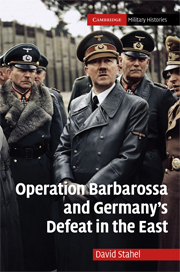Halder, Franz,
Kriegstagebuch: Tägliche Aufzeichnungen des Chefs des Generalstabes des Heeres 1939–1942, Band I: Vom Polenfeldzug bis zum Ende der Westoffensive (14.8.1939 – 30.6.1940); Band II: Von der geplanten Landung in England bis zum Beginn des Ostfeldzuges (1.7.1940 – 21.6.1941), ed. Hans-Adolf Jacobsen and Alfred Philippi (Arbeitskreis für Wehrforschung,
Stuttgart,
1962); Band III: Der Russlandfeldzug bis zum Marsch auf Stalingrad (22.6.1941 – 24.9.1942), ed. Hans-Adolf Jacobsen and Alfred Philippi (Arbeitskreis für Wehrforschung, Stuttgart, 1964). Abridged English translation: Halder, Franz, The Halder War Diary 1939–1942, ed. Charles Burdick and Hans-Adolf Jacobsen (London, 1988).
Google Scholar 


